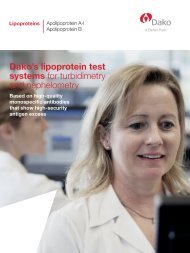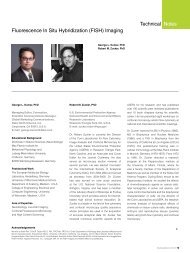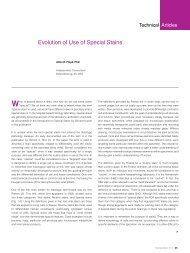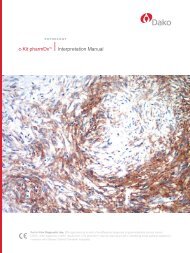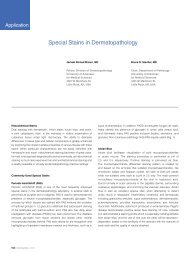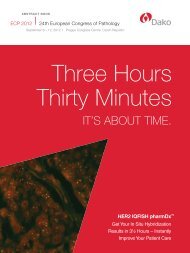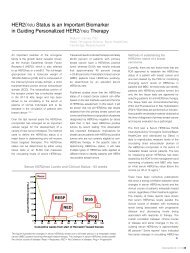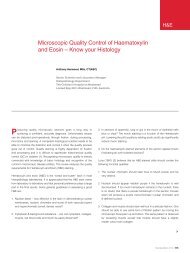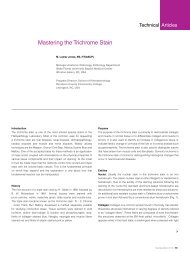Construction and Quality Assurance - Dako
Construction and Quality Assurance - Dako
Construction and Quality Assurance - Dako
You also want an ePaper? Increase the reach of your titles
YUMPU automatically turns print PDFs into web optimized ePapers that Google loves.
Tissue Microarray — <strong>Construction</strong> <strong>and</strong> <strong>Quality</strong> <strong>Assurance</strong>Consecutive case array: This type of array is constructed usingconsecutive cases belonging to a single tissue site. These types ofarrays are extremely useful for quality control purposes includingidentifying shifts <strong>and</strong> drifts in reagent quality. They are also useful instudying the prevalence of a protein/antigen in a given tumor type <strong>and</strong>analyzing the relationships between different biomarkers.Tumor characteristic-based array: This is a special type constructedsolely on the basis of a given characteristic such as patient age ortumor grade. The latter is useful for evaluating the frequency of amarker throughout the spectrum of tumor differentiation. SimilarlyTMAs can be generated based on the expression of a biomarkersuch as estrogen receptor or HER2/neu positive or triple negativebreast cancers. These types of biomarkers are useful in analyzinginterrelationships between different cellular pathways.Progression arrays: These types of arrays are used to analyze therole of protein(s) in cancer progression <strong>and</strong> consist of normal tissuesfrom patients without cancer, normal tissue from patients with cancer,pre-invasive lesions <strong>and</strong> tumor (from local <strong>and</strong> metastatic sites). Theaddition of normal tissue from close to the tumor <strong>and</strong> those muchfurther away from the tumor site might enable study of “field effect”.Outcome based arrays: These are the most valuable <strong>and</strong> mostdifficult to generate as they involve collation of tissues from patientsthat have the same disease <strong>and</strong> have been more or less similarlytreated <strong>and</strong> followed up for a significant period of time. The periodof follow-up depends on the type of disease or tumor being studied.These types of arrays are mostly used to evaluate prognostic orpredictive biomarkers. The presence of biomarkers in tumor subtypesmight then be used to design novel therapeutic strategies.Other special types: TMAs can be generated based on specificquestion being asked whether it be race (Caucasians versus AfricanAmericans), sex (male versus female) or more tissue orientedquestions such as center of the tumor versus invasive edge ofthe tumor.Team Required for TMA <strong>Construction</strong><strong>Construction</strong> of TMA is a team effort. The first <strong>and</strong> foremost questionthat needs to be answered is why is the TMA being constructed?This will decide the composition of the team. For the generationof the simplest of TMA, a technologist might be all that is required.However, most TMA synthesis will require close collaboration withthe pathologist, who will identify the areas of interest <strong>and</strong> mark themfor the technologists to obtain cores. It is a good idea to involvebiostatisticians from the onset rather than just asking them to dothe data analysis. They can help with deciding the number of coresfrom each case, total number of cases needed, how they should bedistributed across the array to avoid bias. In general the number ofcases required in a TMA is dependent on the size of the differenceexpected in the outcome <strong>and</strong> the degree of variance in the samples;this sample size calculation is best done with the assistanceof a statistician. Outcome based TMAs may need input from orparticipation of treating physicians/oncologists.Steps Involved in TMA <strong>Construction</strong>The following steps are recommended for breast TMA construction:Step 1. Define the questionAs described above TMAs are created to answer specific questions. Itis important to clearly define this question at the outset. The questionwill help define the number of cases <strong>and</strong> cores that need to be used inthe generation of the TMA. For example a TMA containing 20 casesmight be sufficient for routine quality control/ assessment but is notenough for biomarker assessment.Step 2. Review the cases to be included in the TMAPull all the cases to be included in the TMA together. If the blockshave been previously cut into for other clinical or research purposes,a fresh H&E slide may be obtained to ensure that the slide isrepresentative of the block. Review all the slides <strong>and</strong> mark areas ofinterest. It is useful to mark multiple areas from more than one block,as blocks may be depleted or misplaced. Areas to be sampled (tumor,normal, <strong>and</strong> pre-malignant tissues) should be identified.IHC Staining Methods, Fifth Edition | 45



